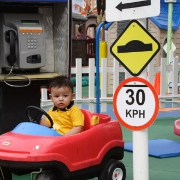 Photo: Getty Images
Photo: Getty Images
A child’s learning can go stale during the summer break. To keep their love of learning alive during summer, simply build it into your daily activities.
When my son and I would run errands, we would read road signs--first for letters and sounds, then words. When he was reading sentences, we read the billboards to one another. On longer trips, Patrick was our designated map and sign reader. We took turns reading books aloud or listening to audio recordings. One summer, we took our son to the library for his very own library card. Check your local public library for various summer reading programs or contests designed to encourage summer reading.
To encourage your child to practice writing, select several fun postcards from a summer vacation spot and mail them to relatives. This is great practice for spelling, capitalization, neatness, letter format, and addresses. It also encourages your student to summarize a main idea from their day and put it into writing. At the end of your vacation, consider asking your child to write a story about it. Our son loved being able to add copies of the snapshots from our vacation as illustrations for his "book". Don’t forget to read these books aloud. Younger children may enjoy cutting pictures from old magazines to illustrate a book on their favorite summer fun or activity. Cutting with scissors requires practice with fine motor skills--the same motor skills needed for grasping and writing with a pencil.
Also look for opportunities to practice real life math. Duke University Professor Harris Cooper reminds us that while reading is naturally a part of our everyday lives, parents are less likely to look for opportunities to practice math. The number of panes in your child’s bedroom window can become a multiplication array or a quick discussion on odd or even, prime or composite numbers. Try counting by 2s, 3s, 5s, and 10s. Pull change from dad’s pocket and practice identifying, sorting, and adding coins. Look out for geometry shapes and notice if they are symmetrical. Train tracks are an awesome example of parallel lines. Use power lines and poles to discuss vertical, horizontal, and perpendicular lines.
As a teacher, I can tell you that a child is completely engaged and learns a multitude of concepts when the lessons come directly from real life. Enjoy a summer of learning and fun with your child!
Source:
http://www.summerlearning.org/resource/collection/CB94AEC5-9C97-496F-B230-1BECDFC2DF8B/Research_Brief_04_-_Cooper.pdf
Reviewed June 9, 2011
Edited by Alison Stanton






Add a CommentComments
There are no comments yet. Be the first one and get the conversation started!